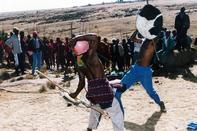Growing Pedi Empire
At the height of their power the Pedi or Maroteng, under the leadership of Thulare (about 1790—1820), were launching frequent, successful raids on the surrounding peoples.

They brought an extensive area stretching from the site of present-day Rustenburg in the east to the Lowveld in the west, and ranging south to the Vaal River (the districts that are known today as the Waterberg and Soutpansberg), under Pedi rule.
The Pedi grew in numbers and strength, incorporating more and more neighbours into their realm. Under the powerful Thulare, the Pedi empire flourished and Maroteng hegemony reached its highest point. Thulare's influence was such that he even became the spiritual leader of surrounding groups that were not under direct Pedi control. In 1824, on Thulare's death, he was succeeded by the eldest of eight sons, Malekutu, who attempted to continue expanding the Pedi sphere of influence.
Southern Pedi Raids
Malekutu’s chieftainship of the Pedi did not last long as, and legend has it, he was poisoned by one of his brothers. The Pedi were in disarray when Nguni raiders struck from the south. Historians are divided as to whether the attackers were the Matabele under the leadership of Mzilikazi, or an Ndwandwe faction under the leadership of Zwangendaba, who had broken away from Zwide after his defeat at the hands of Shaka.
In either event, the Pedi were overwhelmed and all of Thulare's sons, with the exception of Sekwati, were killed. The Nguni raiders stayed for about a year, during which they harvested all the crops they could and denuded the land of cattle. Many surrounding groups became destitute and are believed, according to present-day oral sources, to have resorted to cannibalism.
Sekwati fled, with what remnants he managed to gather of the Pedi nation, across the Olifants River. For four years they sought refuge in the neighbouring, and related, chiefdom of Ramapulana. They made periodic raids against small settlements, during which they captured women and cattle.
Eventually, Sekwati re-crossed the Olifants River and established his headquarters at Phiring. Slowly he brought together the scattered elements of the Pedi group and re-established Maroteng dominance in the area. He managed to resist attacks from both the Swazi and Zulu, by withdrawing to the surrounding mountain fastnesses, eventually establishing his capital at Téate, under the eastern slope of the Leolo Mountains.
Uneasy Peace
In 1845 Boer leader Hendrik Potgieter settled east of the Steelpoort, where he founded the present-day Ohrigstad. On 5 July that year, Potgieter and Sekwati signed a treaty, granting Potgieter title to this land. An uneasy peace existed between the Pedi and the increasing numbers of Boers, punctuated by periodic cattle raids by the Pedi and Boer counterattacks. Pedi access to weaponry had by this time extended.
The paramount chief had started to send out groups of young men to work as labour migrants in the Cape, Delagoa Bay and on the diamond fields in the Northern Cape. By the 1870s, each man returning from work was paying about £1 to the paramount, which was used to buy guns and ammunition. After Sekwati's death, there were disputes between two of his sons, Sekhukhune and Mampuru, about the succession to the paramountcy.
This was exacerbated by the presence of the Boers, who presented a threat to continuing Pedi authority. Sekhukhune's eventual success in containing these disputes, and in establishing his legitimacy as heir, was visible in his ability to summon regiments of fighting men from the chiefdoms subordinate to his, in order to put down rebellions by other chiefs no longer content with his rule.
Sekhukhune initially had friendly relations with the Boers, but intensifying struggles over land and labour saw these steadily deteriorate until finally, on 16 May 1876, the Transvaal Volksraad declared war after hearing a rumour about an impending Pedi attack on the Boer village of Lydenburg. The Boer aggressors suffered a resounding defeat.
Two months later Sir Theophilus Shepstone annexed the Transvaal Republic on behalf of the British Crown, partly spurred by Boer failure to subjugate the Pedi. After the Zulu War ended in July 1879, Sir Garnet Wolseley (High Commissioner for South-Eastern Africa), confident that Sekhukhune would sue for peace, offered onerous conditions, fining Sekhukhune 2 500 head of cattle. Sekhukhune refused these terms, and Sir Garnet mobilized a force of some 12 000 men, including 8 000 Swazi warriors. On 28 November 1879, after severe fighting in which over 1 000 Pedi warriors were killed, Sekhukhune was finally defeated. He was captured in a cave and imprisoned in Pretoria. And, with this, the Pedi empire was finally destroyed.